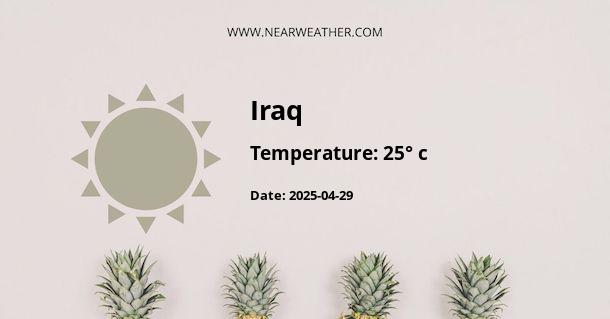Climate and Weather in the Republic of Iraq
The Republic of Iraq, often simply referred to as Iraq, is a country located in Western Asia. It's bordered by six countries: Turkey to the north, Iran to the east, Kuwait to the southeast, Saudi Arabia to the south, Jordan to the southwest, and Syria to the west. In terms of climate, Iraq is characterized by a desert climate, although there are significant variations across the country.
Geographical Overview
Spanning an area of approximately 438,317 square kilometers, Iraq's terrain ranges from vast desert plains to mountainous regions, with elevation influencing local weather patterns. The Tigris and Euphrates rivers traverse the country, emptying into the Shatt al-Arab near the Persian Gulf.
Climate Zones
Iraq's climate can be categorized into three main zones:
- The desert zone in the west and southwest, where summers are extremely hot and dry while winters are cool and slightly rainy.
- The northwest highlands or mountainous region, which experiences cold winters and mild, wet summers.
- The alluvial plains near the Tigris and Euphrates rivers, where summers are extremely hot, and winters are cool to mild with moderate rainfall.
Seasonal Weather
Generally, Iraq experiences two distinct seasons: a hot, dry summer from May to October, and a cool, rainy winter from November to April. The transitional periods in spring and autumn are relatively brief.
Summer
Summers in Iraq are scorching, especially in the desert regions where temperatures can exceed 50°C (122°F). Even in the cooler highlands, temperatures often reach into the mid-30s Celsius (mid-90s Fahrenheit). This period is also characterized by a phenomenon known as "shamal," a northwesterly wind that can cause severe sandstorms.
Winter
Winters in Iraq are considerably cooler, with average temperatures ranging from 5-15°C (41-59°F) in the desert regions, and dropping below freezing in the mountainous regions. This is also the main period for rainfall, particularly in the north and northeast.
Annual Rainfall
The amount of annual rainfall varies significantly across the country. The mountainous region in the north receives the highest rainfall, averaging 1000mm per year, while the central and southern regions receive less than 250mm annually.
"Although Iraq's climate is generally arid, the country's weather patterns are shaped by its diverse geography and the two major rivers, Tigris and Euphrates."
Climate Change Impact
Like many countries around the world, Iraq is feeling the impacts of climate change. Increased temperatures and decreased rainfall are exacerbating existing water scarcity issues. The Intergovernmental Panel on Climate Change predicts that the Middle East and North Africa region will become hotter and drier, affecting agricultural productivity and potentially increasing the frequency of extreme weather events.
Conclusion
From its scorching summers to its mild winters, Iraq's climate is as diverse as its landscape. Understanding the nuances of its weather patterns is key for anyone planning to visit or do business in the country. As global temperatures rise, Iraq, like many countries worldwide, must also confront the challenges posed by climate change.
A - Iraq's Latitude is 33.000000 & Longitude is 44.000000.
A - Weather in Iraq is 25° today.
A - Climate Conditions in Iraq shows overcast clouds today.
A - Humidity in Iraq is 36% today.
A - Wind speed in Iraq is 12.64 km/h, flowing at 266° wind direction. today.
